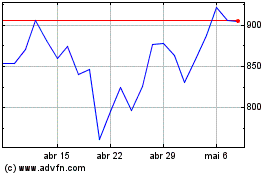Nvidia Unveils Blackwell: The Next-Gen AI Architecture Powering the Future of Computing
19 Março 2024 - 7:35AM
IH Market News
Nvidia (NASDAQ:NVDA) unveiled its latest advancement in graphics
processor architecture named Blackwell on Monday, marking a
significant leap forward from its existing Hopper technology. This
new development aims to enhance the performance and efficiency of
artificial intelligence (AI) systems, such as OpenAI’s ChatGPT,
cementing Nvidia’s role as a key player in the AI hardware market.
With a market value of $2.195 trillion as of last Friday, Nvidia
stands as the third-largest company globally, trailing only behind
tech giants Apple (AAPL) and Microsoft (MSFT).
The announcement was made at Nvidia’s event in San Jose,
California, which drew an estimated crowd of 20,000 attendees.
Dubbed the GPU Technology Conference (GTC), or “The Woodstock of
Artificial Intelligence” by Bank of America analyst Vivek Arya, the
event highlighted Nvidia’s increasing prominence in the tech
industry.
Nvidia’s Blackwell architecture promises a revolution in
generative AI capabilities, allowing systems to analyze up to 10
trillion parameters simultaneously, with a 25-fold reduction in
energy consumption and cost compared to its predecessors. During
the event, Nvidia CEO and co-founder Jensen Huang hailed the new
technology as the driving force behind a new industrial
revolution.
The Blackwell architecture will power the NVIDIA GB200 Grace
Blackwell, a high-performance computing solution comprising two
Blackwell GPUs and a Grace processor, tailored for server platforms
used in AI model training and execution.
Tech giants such as AWS (Amazon), Microsoft, Google (Alphabet),
and Oracle are among the first to receive Nvidia’s cutting-edge
technology. Additionally, companies like Cisco, Dell, Hewlett
Packard Enterprise, Lenovo, and Supermicro have struck deals to
offer servers equipped with Blackwell GPUs.
Nvidia’s launch comes at a time when AI technology is fueling
unprecedented growth for the company, with record-breaking sales
figures and a surge in market valuation, mirroring the broader tech
industry’s upward trend. In the fourth quarter alone, Nvidia
reported a 265% year-on-year revenue increase to $22.1 billion,
while net income soared to $12.829 billion, a 491% rise.
The AI boom has also prompted Nvidia’s competitors to step up
their game. AMD introduced its MI300 AI chip series in December,
aiming to challenge Nvidia’s dominance, while Intel announced its
Gaudi 3 line, targeting the AI accelerator market later this
year.
Originally founded in 1993, Nvidia was best known for its
graphic processing units (GPUs) popular among gamers. However, the
2000s saw a shift as researchers began leveraging GPUs for parallel
processing in AI applications, a task at which they excelled over
traditional CPUs. Recognizing this potential, Nvidia developed
Cuda, a programming language for GPU-based applications, and
shifted its focus towards high-performance chips for servers,
further establishing its foothold in the AI hardware market.
NVIDIA (NASDAQ:NVDA)
Gráfico Histórico do Ativo
De Mar 2024 até Abr 2024

NVIDIA (NASDAQ:NVDA)
Gráfico Histórico do Ativo
De Abr 2023 até Abr 2024
